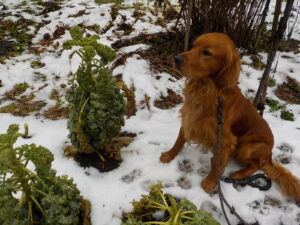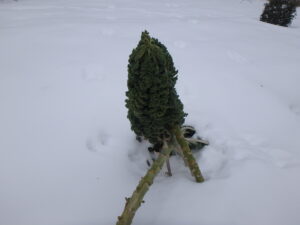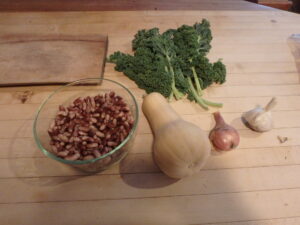In Praise of Kale, the Misunderstood Vegetable Hero
Posted on Tuesday, December 7, 2021 · Leave a Comment
Like Rodney Dangerfield, kale doesn’t get enough respect. I’ve been told that it only became a commonly grown vegetable in the 1970’s when salad bars ordered it to use as the bed upon which other edibles like tomatoes, carrots and cukes slept on in nearly ordered arrangements. No one actually ate kale. But that has changed, at least with the Birkenstock crowd. Like me, for one.
Kale became the carpet for other veggies because it is a deep, rich green, and seemingly never wilts. It is the toupee of veggies, always looking neat and presentable. I often pick a few leaves and place the stems in a jar of water on the kitchen counter to remind me to include it in soups, stews, scrambled eggs and more. And to admire.

December kale with Rowan, our new dog
On a recent raw December morn I took our new dog out for a walk. Rowan is a year-old Irish setter/golden retriever mix we adopted just before Thanksgiving. As he zoomed around the property I stopped to see how our kale is doing. Still healthy, despite occasional temps down to 15 degrees, and now covered with wet snow. I picked a few leaves and brought them up to include in a soup or salad.
Kale is crunchy. In a salad I cut it finely, blending it in with lettuce, although my wife, Cindy, recently made a kale salad. She also used walnuts, crispy rice and dried cranberries – and it was delicious. She massaged the fine-cut leaves with olive oil for a couple of minutes first to help make it less crunchy.
It is one of the more nutritious greens. Compared to iceberg lettuce, it has two and a half times more fiber. It has more thiamin, riboflavin, niacin, pantothenic acid, Vitamin B6 and folate than iceberg lettuce. It is a great source of Vitamin A, Vitamin C, Vitamin K, calcium, and potassium. It has twice the calories of iceberg lettuce, but neither is a high-calorie food. You can eat all the kale you want and not gain an ounce of fat.

Kale in the garden in February
One of my favorite ways to eat kale is in a green smoothie for breakfast. I use about 2 cups of kale removed from the center rib, a banana, half an avocado (if I have one), half a cup of orange juice and a cup and a half of water. Oh, and I squeeze half a lime into the mix, and grate in some fresh ginger if I have it. I chop the kale very, very finely because my older blender doesn’t liquefy it, even though the dial says “Liquefy”. I don’t want to have to chew my smoothie.
Sometimes I add frozen blueberries or raspberries to the mix, or if I want a cold smoothie, I substitute ice cubes for some of the water. In summer when I have lots of greens I try to add 4 or more leaves of other greens – lettuce, Swiss chard, or whatever looks good. Spinach is good, and very nutritious. It freezes well after a brief blanching.
Growing kale is easy. I rarely find the leaves eaten by insects, though some readers have written me about flea beetles (or something) eating holes in the leaves. You can stymie most bugs by covering the plants with a layer of “row cover”. Row cover is a spun agricultural fabric that looks like those dryer sheets available to reduce static and add fragrance to laundry. But this stuff comes in long 60-inch wide pieces. Wires are sold to form hoops over small plants, but you can drape it right on bigger plants. It is great for keeping potato beetles away from you spuds, too.
Kale is a big plant. I grow it 18 inches apart in a wide, raised bed. It grows best in full sun, but if sun is at a premium in your garden, it will do fine in part shade. Hot afternoon sun and dry soil is not ideal for kale. I recommend adding plenty of compost in the planting hole, and some slow-release organic fertilizer.
Sometimes I start kale from seed indoors six weeks before planting it outside, but if too busy, I just buy some started plants from my favorite farm stand. If you start your own kale indoors, you may get tall, lanky plants – due to not enough light inside. No problem. Bury some of the stem. Just pinch off some lower leaves, and plant the kale deep in the soil so it is not flopping over when it goes in the ground.

A few ingredients for my soup – dry beans, kale, scallion, garlic
I make a great winter stew using kale and other garden vegetables that I have either stored or frozen. It can be either vegetarian or not. It is loosely based on a Portuguese stew I ate years ago on Cape Cod. I don’t think you need a step-by-step recipe, nor do I know the exact proportions, but I share with you my carnivore version and you can make your own according to your preferences – and what you have available.
I start by slicing a pound of Linguica Portuguese sausage into smallish cubes and browning in olive oil with onions and/or leeks (which I always have in the freezer). If you don’t find Linguica, substitute any spicy sausage like Andouille Cajun sausage.
Then I add water and tomatoes. I freeze tomatoes whole in September, so I use those, chopped up, but you could use a 28 oz can of diced tomatoes. Into the stew goes a couple of cups of chopped kale. Then I add herbs – parsley, fennel seed, oregano and marjoram. And carrots, for sweetness.
Lastly I add something to give the stew rib-sticking goodness: either potatoes, winter squash or cooked dry beans. I let the stew simmer until hunger overwhelms me, but I always make plenty as it is good warmed up for days.
So remember to plant plenty of kale next spring. It won’t disappoint you.
Henry’s book, “Organic
Gardening (not just) in the Northeast: A Hands-On, Month-by-Month Guide” is available from him, signed, for $19. Send a check to PO Box 364, Cornish Flat, NH 03746. Or, if you want to use PayPal, go to his website,
www.Gardening-Guy.com.





